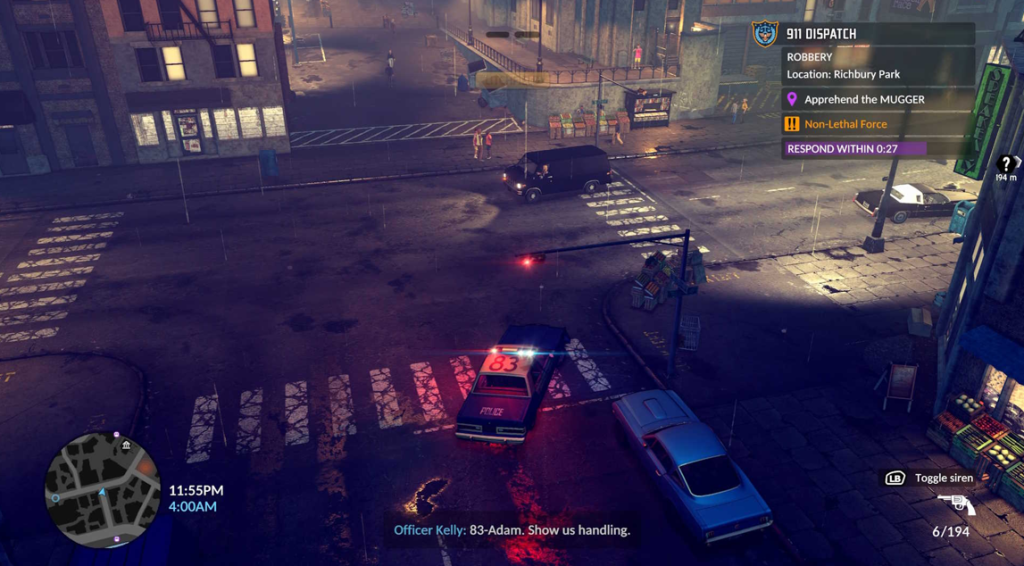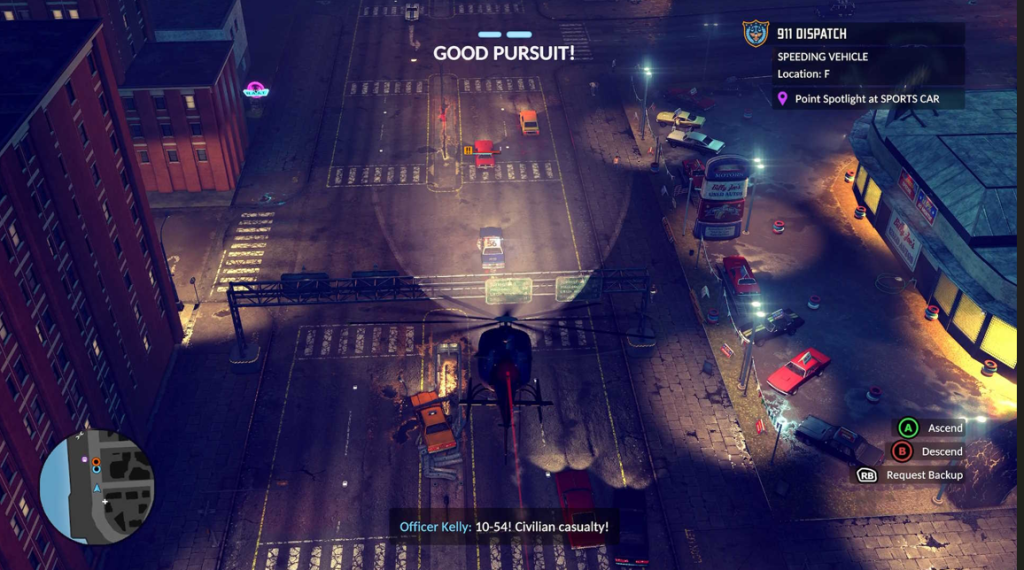Averno City, 1983. Sirens wail, neon lights flicker across rain-slicked streets, and chaos reigns. Into this storm steps Nick Cordell Jr, rookie cop and the player’s avatar in The Precinct.

Setting and Atmosphere: A Living, Breathing 1980s Metropolis
The first thing that struck me about The Precinct was its unapologetic embrace of 1980s noir aesthetics. Averno City is a character in its own right-gritty, vibrant, and alive with detail. The top-down perspective, reminiscent of early GTA titles, might seem limiting at first, but it actually enhances the feeling of surveying a city on the brink. Every district, from the glitzy financial sector to the rundown projects, pulses with its own unique crime profile and atmosphere. The dynamic day/night cycle and shifting weather patterns add layers of unpredictability, making each patrol feel distinct and immersive.
The developers have poured an impressive amount of granular detail into the environment. From vandalized phone booths to era-appropriate vehicles (think off-brand Mustangs and boxy Caprice cop cars), every corner of Averno is meticulously crafted. The neon glow of sirens at night, the rain-soaked streets, and the subtle outlines on vehicles all contribute to a visual style that’s both nostalgic and fresh. Slowing down to take it all in, I found myself genuinely appreciating the care that went into building this world.
Gameplay Loop: Patrol, Pursue, and Police
At its core, The Precinct is about the day-to-day grind of police work-patrolling, responding to crimes, and upholding the law. The game’s structure is built around procedurally generated incidents, ensuring that no two shifts are ever quite the same. One moment you’re issuing a routine parking ticket; the next, you’re caught in a high-speed chase after a bank robber who just bolted when you asked to check their trunk.
The range of police activities is impressive. On foot, you can deescalate conflicts, check IDs, and use non-lethal force (baton or stun gun) when necessary. When things escalate, you have access to firearms, though the game encourages following proper protocol-straying from the rules results in fewer experience points and slower progression through the upgrade tree. This system rewards ethical policing, a nuance I appreciated as someone who values realism in simulation games.
Vehicle gameplay is a highlight. Car chases are intense, chaotic affairs, with destructible environments that let you smash through fences and alleyways in pursuit of suspects. The support system allows you to call in backup, roadblocks, and spike strips using earned tokens, adding tactical depth to pursuits. Helicopter patrols, though present, felt underwhelming and could benefit from more interactive elements in future updates.

Story and Character: Cop Drama
The narrative in The Precinct centers on Nick Cordell Jr. investigating his father’s murder while navigating the tangled web of Averno’s criminal underworld. The story unfolds through static, portrait-driven dialogue scenes-serviceable, if not particularly gripping. The writing leans heavily into genre clichés, with hardboiled detectives and over-the-top villains populating the cast. While the plot isn’t the main draw, it provides enough motivation to keep pushing forward, especially as new missions unlock with each chunk of evidence collected during patrols.
What I found most engaging was the game’s exploration of the blurred lines between law enforcement and organized crime. There’s an underlying commentary on corruption and the challenges of policing a city that seems perpetually on the edge. However, the execution sometimes falls short, with dialogue and scripted missions occasionally feeling awkward or repetitive.
The game shines in its art direction rather than raw fidelity. The illustrated look of vehicles, atmospheric lighting, and attention to environmental detail all contribute to a sense of place that’s rare in indie titles. That said, some areas of the map do feel repetitive, and there’s room for greater district variety in future content updates.
Strengths: Dynamic Sandbox, Addictive Gameplay, and Authentic Vibe
What truly sets The Precinct apart is its dynamic, reactive world. The sheer volume and variety of crimes-ranging from petty infractions to full-blown gang wars-keep the gameplay loop addictive. The city feels alive, with citizens and criminals reacting unpredictably to your presence. I loved how a simple traffic stop could spiral into a multi-stage pursuit, complete with backup units, spike strips, and a satisfying arrest at the end.
The game’s commitment to simulating the mundane aspects of police work-writing reports, booking suspects, and following protocol-adds authenticity without bogging down the action. It’s a delicate balance that few games in the genre manage to achieve.
Weaknesses: Repetition, Clunky Controls, and Missed Opportunities
Despite its many strengths, The Precinct isn’t without flaws. The most glaring issue is repetition. While the procedural generation of crimes keeps things fresh initially, the core activities can start to feel routine after extended play. The grind for evidence to unlock story missions, in particular, can become tedious.
Movement controls are another sore spot. Walking speed often doesn’t match your AI partner’s, making some missions frustrating. The inability to shoot from cover and the limited selection of non-lethal tools also detract from the tactical depth. Escort units leaving their cars blocking the road and the lack of options to tow vehicles are small but noticeable oversights for a game that prides itself on realism.
Helicopter patrols, while a novel idea, are underdeveloped, and the city-though vibrant-could benefit from more diverse interiors and interactive elements. The story, while serviceable, lacks the emotional punch of genre standouts like L.A. Noire or even the grit of Battlefield Hardline.

My Personal Experience: Addictive Chaos and Room for Growth
Having spent considerable time patrolling Averno’s streets, I can confidently say The Precinct is one of the interesting games I’ve played in the cop game genre. The sense of unpredictability-never knowing if a routine stop will explode into chaos-kept me coming back for “just one more patrol.” The improvements since the demo are palpable, with greater attention to detail and a smoother overall experience.
Yet, I can’t shake the feeling that The Precinct is only scratching the surface of its potential. With more crime types, deeper AI, and expanded city districts, this could evolve into a true genre classic. The foundation is solid, and I’m hopeful that future updates will address the game’s rough edges and expand its scope.
The Precinct is a vibrant, chaotic, and deeply immersive simulation of police work in a neon-soaked 1980s city. Its dynamic sandbox gameplay, authentic atmosphere, and addictive patrol loop make it a standout title for fans of cop dramas and open-world action alike. While it suffers from repetition, clunky controls, and a story that never quite rises above cliché, the core experience is undeniably compelling.
If you’re a fan of police sims or looking for a fresh twist on the sandbox formula, The Precinct is a hidden gem-one that’s just a few patches away from greatness.